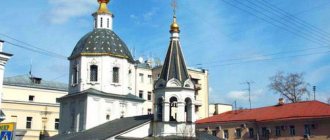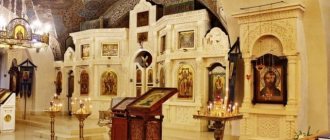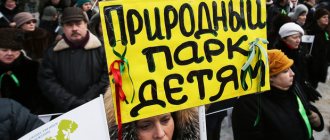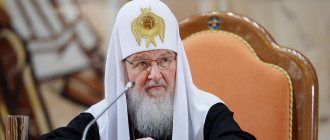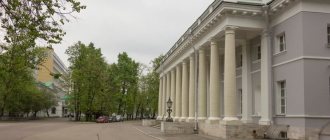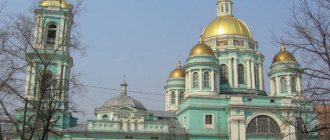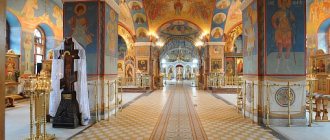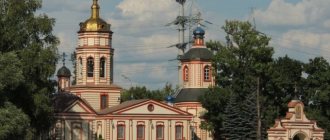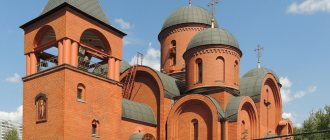Bolshaya Nikitskaya - Church of the Ascension of the Lord (“Little Ascension”)
Address: Moscow, st. Bolshaya Nikitskaya, 18/1.
The Church in honor of the Ascension of the Lord on Bolshaya Nikitskaya Street in the White City is also called the “Small Ascension”. This began in the early thirties of the 19th century. There is also a “Great Ascension” in the capital - this is a temple outside the Nikitsky Gate.
Starting from the second half of the 14th century, the road to Veliky Novgorod through Volokolamsk passed next to the wooden temple. There is a version that the parish was born as the center of a settlement of Novgorod and Ustyug residents.
The stone church “in place of the ancient one” was erected by Tsar Fyodor Ioannovich - in honor of his coronation on the day of the Feast of the Ascension of the Lord Jesus Christ.
In 1548, a mention of the temple appears in the chronicle - Prince Pyotr Shuisky caught here, “in a posad in the courtyard near the Ascension, near a good bell tower behind Neglinnaya on Nikitskaya Street on November 11,” Prince Mikhail Glinsky, who was fleeing from Ivan the Terrible.
The Romanov boyars historically settled near the temple, from whose family came the mother of Theodore Ioannovich - Empress Anastasia Romanova, the first wife of Ivan the Terrible.
In 1871, the area next to the temple became musical - when the Moscow Conservatory stood on Bolshaya Nikitskaya Street, its workers became parishioners of the “Little Ascension”.
In the 1930s, the church was closed and rebuilt into a dormitory and workshops. Services were resumed only in June 1992.
Moscow. Church of the Ascension of the Lord outside the Serpukhov Gate
Article added by:
Igor Demin, May 1, 2010
The temple was built in 1714-1718 at the expense of Tsarevich Alexei Petrovich. The Lower Church of the Jerusalem Icon of the Mother of God was consecrated in 1714. After the execution of Alexei in 1718, construction was suspended; the unfinished upper church was covered with a temporary wooden roof.
At the request of parishioners, construction was resumed in 1756, and by 1762 the church building was completed. In 1839, a refectory was added to the upper church, and in 1842 a bell tower was erected.
The temple was closed in 1929, in 1930 they began to dismantle it, starting with the bell tower. All the upper tiers of the bell tower, starting from the second, were destroyed, and the octagonal drum with the dome on the church itself was destroyed.
Returned to believers in 1990.
Article added by:
Kachalin Alexander Anatolyevich, April 21, 2014 In 1696, the Danilov Monastery donated a plot of its land outside the Serpukhov Gate of the Zemlyanoy Town for the construction of a church here. A wooden church in the name of the Ascension of the Lord with a chapel of the 9 Martyrs of Kizichesk was soon built, the chapel was consecrated, and the main church was consecrated only in 1700. The stone church was built at the expense of Tsarevich Alexei Petrovich. The decree for the construction of the church was issued on September 12, 1709 (according to other sources - in 1708), during the period of prohibition of stone construction in Moscow. On October 9, 1714, the lower church was consecrated in the name of the icon of the Jerusalem Mother of God with the side chapels of the 9 Martyrs of Cyzicus and Alexius the Man of God. After the execution of Tsarevich Alexy and the cessation of funds, construction was suspended. The upper temple was erected to the upper windows and covered with a temporary roof. The separate bell tower was also not completed. In the passage between the bell tower and the temple there was a staircase to the second tier, surrounded by a walkway. In the 1730s. parishioners repeatedly petitioned for help to continue construction, but they received permission to raise funds only on May 18, 1756. In July 1762, the church was completed and consecrated. The temple drum was originally a light drum. The architects who built the temple are unknown. Assumptions have been made about the authorship of D. Trezzini, as well as the participation of I. F. Michurin and V. D. Ukhtomsky in the completion of the temple. The Ascension Church had a significant territory overlooking Bolshaya and Malaya Serpukhovskaya streets, as well as on the lane later named after the temple Voznesensky .In 1757, a one-story stone almshouse was built next to the temple. The courtyards of the clergy, and later several stone two-story houses, were located on the other side of the alley. In the 1830s - 40s. The temple underwent significant reconstruction. In 1832, at the expense of the headman of the Remizov church, a new two-story refectory was built, and a passage was built over the previously open staircase. In 1845, iconostases were installed in the new aisles of the lower refectory, dedicated to St. Nicholas the Wonderworker and Sergius of Radonezh. Two new upper tiers in the Empire style were built over the bell tower in 1842. During this period, the roofs and bars in eight windows were also replaced, the base was corrected, new plaster was made on the facades, the carpentry was replaced, the bars around the altar of the upper church were replaced, and the cross was again gilded. Domes with crosses were placed over the new chapels. The paintings in the church were repainted several times. The surviving pictorial layer in the style of late classicism dates back to the end of the 19th century. In 1929 the temple was closed, in 1930 the fence and bell tower were destroyed, the almshouse and fence were destroyed, and government institutions were located inside. The houses on the other side of the alley have been preserved. The head of the temple was dismantled, the lower tier was greatly rebuilt (windows were widened, openings were broken). On February 1, 1995, a resolution was received from the office of His Holiness the Patriarch of Moscow and All Rus' with a blessing to consecrate the stone for laying the bell tower. On December 5, 1994, the Order “On approval of the act of the state commission” was issued on the acceptance into operation of a shelter for children on the territory of the Church of the Ascension of the Lord,” and on December 15, 1994, a Certificate of Registration of the Orthodox Children's Home-Shelter at the Church of the Ascension of the Lord was issued.
https://voznesenie.ru/history/
Article added by:
Kachalin Alexander Anatolyevich, April 21, 2014 One of the “long-term construction projects” of his era, closely connected with Russian history: the disgrace of Tsarevich Alexei Petrovich, the construction of St. Petersburg, the eras of atheism and church revival. At the end of the 17th century. the area near the Serpukhov Gate was actively populated by artisans and traders. Over time, it became necessary to build a separate temple for new residents. In 1696, a wooden church in the name of the Ascension of the Lord appeared on a plot of land donated by the Danilov Monastery. But this temple also turned out to be not spacious enough: in 1708, permission was issued for the construction of a large stone building, and Tsarevich Alexei Petrovich himself became the temple builder. Construction proceeded successfully: in 1714, the lower church was consecrated in the name of the Jerusalem Icon of the Mother of God with two chapels - the Nine Martyrs of Cyzicus and Alexius the Man of God (in honor of Tsarevich Alexei). The Upper Ascension Church was built from the vaults to half the windows. However, the work was soon interrupted: in 1714, a decree was issued banning stone construction everywhere except St. Petersburg. In 1716, Tsarevich Alexei secretly fled to Vienna and took a hostile position towards Peter I; in 1718, he was deceived into Russia, sentenced to execution and died in the Peter and Paul Fortress. All these circumstances stopped construction. To preserve the built part, the parishioners covered it with a temporary wooden roof. Only in 1762 was the temple consecrated in its appearance, which, with changes, has survived to this day. The architect, apparently, was D. Trezzini (Peter and Paul Cathedral, St. Petersburg). The names of I.F. are also mentioned. Michurin and D.V. Ukhtomsky, who completed the construction of the temple. The main upper temple on a wide walkway in plan is a cross, completed in the center by an octagon with one chapter of a complex shape (in Baroque aesthetics). The facades are decorated with large elongated windows, round windows and pilasters. The facades of the lower tier are almost devoid of decor. In 1839, a refectory was also built at the upper church. In 1842, a four-tiered bell tower topped with a spire appeared above the western entrance. Services here continued until 1929. The temple was closed and scheduled for demolition. But only the bell tower and fence were dismantled, the rest was converted into a refrigerated warehouse. At the same time, the temple lost its head with a drum, and the lower tier was rebuilt. Later there was a hostel, offices, and a computer center for one of the ministries. The interiors have been lost. Restoration began in 1991, simultaneously with the resumption of services. Experts discovered former church paintings under the plaster, and the Jerusalem Icon of the Mother of God, which belonged to the church, was brought from the Danilov Monastery. Today the temple has been restored to its early 20th century appearance, the dome, bell tower, and interiors have been recreated. Nearby, a building for an orphanage was built with a house church in the name of the New Martyrs and Confessors of Russia. A little further away, a church-chapel was erected in the name of Equal-to-the-Apostles Princess Olga. Author of the article Nikita Brusilovsky https://um.mos.ru/houses/7353/
Church of the Great Ascension at the Nikitsky Gate (“Great Ascension”)
Address: Moscow, Bolshaya st., 36.
The wooden church of the “Ascension of the Lord in Storozhi”, or, as it is also called, the “Great Ascension”, was first mentioned in chronicles in the 15th century.
In 1629 the church burned down. In 1685-1689, Tsarina Natalya Naryshkina, whose courtyard was next door, built the stone Ascension Church in its place.
In the 18th century, the site under the temple became the property of Prince Grigory Potemkin. According to legend, it was at the throne of the Church of the Ascension in 1774 that the secret wedding of the prince and Catherine the Great took place.
In 1831, the old church was dismantled, leaving only the bell tower. The building according to the new project was completed only in 1848. The parishioners of the “Great Ascension” were representatives of the intelligentsia, nobility and merchants who lived nearby. In 1863, the funeral service was held here for the founder of the Russian acting school, Mikhail Shchepkin, and in 1928, for the great actress Maria Ermolova.
In 1925, the last Divine Liturgy was celebrated in the Church of the Ascension by Patriarch Tikhon of Moscow and All Russia. The Soviet authorities closed the church in 1931 and destroyed the ancient bell tower in 1937.
Until 1987, the church building housed a container warehouse and a laboratory of the Research Institute named after. Krzhizhanovsky. In 1990, the building was restored and returned to the Russian Orthodox Church.
Church of the Ascension of the Lord outside the Serpukhov Gate
The construction of the lower temple of the church (in the name of the icon of the Mother of God of Jerusalem with the side chapels of the 9 Martyrs of Cysis and Alexius, the Man of God) began in 1714 on the land plot of the Danilov Monastery, at the expense of Tsarevich Alexy, son of Peter I. After the execution of the Tsarevich in 1718, construction was suspended. The upper church was temporarily covered with a wooden roof.
Construction was resumed at the request of parishioners in 1756, and completed in 1762. The participation of the famous architect Trezzini in the construction of the temple seems most likely to historians, but has not been definitively confirmed.
In 1757, a one-story stone almshouse was built near the temple. The parish also owned the houses and courtyards of the clergy.
note
In 1830 - 1840, the temple was significantly rebuilt, in particular, in 1832 a new two-story refectory was built, and a superstructure was made over the temple staircase
In 1842, a bell tower was built on 2 tiers, and in 1845, two chapels were built in the refectory: St. Nicholas the Wonderworker and St. Sergius of Radonezh.
The painting in the church was also repeatedly altered, most recently at the end of the 19th century.
Services in the temple were stopped in 1929, the temple itself was closed, and it was going to be demolished, but only the bell tower and the almshouse were destroyed. The almshouse and fence were destroyed. The remaining buildings underwent significant reconstruction and were given over to government institutions.
The revival of the temple began in 1990 with the registration of the church community. In 1991, restoration of the temple began. Initially it was believed that the interior of the church was lost, but paintings were discovered under the plaster. The image of the Mother of God of Jerusalem, which was located in the Danilov Monastery, was returned to the church.
At the moment, the restoration of the temple is almost complete, the thrones have been consecrated in it:
Ascension of the Lord, Jerusalem Icon of the Mother of God. St. Alexy, man of God, St. Sergius of Radonezh, St. Nicholas.
At the temple there is an orphanage with a newly built house church in the name of the New Martyrs and Confessors of Russia.
Important
Also on the territory belonging to the church, a temple-chapel was built in the name of Equal-to-the-Apostles Princess Olga.
Among the shrines of the temple: the image of the Jerusalem Icon of the Mother of God, the image of the “Old Testament Trinity” and the “New Testament Trinity” with a particle of the bark of the Mamre oak (the tree under which Abraham met the Lord); icon of Peter and Fevronia of Murom with particles of their relics.
Source: https://rublev.com/hramy/tserkov-vozneseniia-gospodnia-za-serpukhovskimi-vorotami
Temple of the Ascension in Kolomenskoye
Address: Moscow, Andropova Ave., 39, building 1.
The Church of the Ascension in Kolomenskoye is the first stone tented church in Moscow. It was built in 1529 - 1532 by order of Grand Duke Vasily III.
On March 15, 1917, the day of Emperor Nicholas II’s abdication from the throne, the miraculous “Sovereign” icon of the Mother of God was found in the Church of the Ascension. Now it is open for worship in the Kazan Church in Kolomenskoye.
The bell tower with the Church of the Great Martyr George the Victorious was built at the temple in the 16th century. There is a version that on the site of its construction stood a temple of an earlier construction - from the time of Demetrius Donskoy. The guess is partially confirmed by a discovery from the beginning of the 20th century - the remains of a cemetery from the 14th - 16th centuries were discovered here.
In the 17th century, a wooden refectory was added to the bell tower, and the bell tower itself was turned into the altar of the temple and consecrated. True, two centuries later, in 1843, the church and refectory were dismantled and rebuilt using decorative elements and proportions of the ancient building.
Since 2003, restoration of the bell tower and St. George's Church has been underway; they promise to restore the lost decor of the temple and iconostasis of the 19th century.
Church of the Ascension - brief description
The Church of the Ascension was built according to the design of the Italian architect Ivan Fryazin (Pietro Antonio Solari), who was working in Russia at that time. The site for the construction was chosen near the place where there was a healing spring, about which there are many legends.
According to one legend, St. George the Victorious (the most revered saint and great martyr in Christianity) chased a snake along the bottom of a ravine on a horse, and everywhere he galloped, springs appeared that healed diseases. The location of the temple is considered holy.
Architecture
The Church of the Ascension was one of the tallest buildings in the Moscow principality, its height is more than 60 meters and for a long time it served as a watchtower. The temple, located in the south of Moscow, was a good observation point on the southern border of the principality, from where danger most often threatened, primarily from Tatar-Mongol raids.
The Church of the Ascension is made in the form of a white stone tower with a high hipped roof, which was an innovation of that time. The tent has clear edges and is decorated with “diamond rustication” - a trim in the form of polyhedrons.
A smooth transition from one tier to another is made by rows of triple kokoshniks. The entrances to the temple are decorated with pointed elements - wimpergs.
The temple is surrounded by a two-tiered gallery with three amazing staircase-arches that fit perfectly into the surrounding area.
Currently, under the western porch there is an entrance to the basement, where an exhibition telling about the history of the temple is displayed. Here you will see photographs and documents, as well as interesting artifacts found by archaeologists.
In the basement of the temple, historians tried to find the famous library of Ivan the Terrible. It was he who was the last owner of valuable books and documents, the search for which has been going on for several centuries to no avail.
Here, in March 1917, the Sovereign Icon of the Mother of God was found, located in the Church of Our Lady of Kazan in Kolomenskoye. Her list is now kept in the basement of the temple.
Interior decoration
The Church of the Ascension was a home summer church for the princely family and therefore its internal space is relatively small - about 100 square meters. meters. Thanks to the predominance of white color and the skillful placement of windows, the inside of the temple is very light and spacious.
Strict decorative decoration emphasizes the grandeur and harmony of the temple. Each element of the decor speaks of Peter Fryazin’s desire to show the lightness and upward aspiration of the structure, symbolizing the ascension of Christ into heaven.
The original painting, as well as the iconostasis of the first third of the 16th century, have not survived. The iconostasis that you will see was recreated in the 17th century from surviving ancient icons.
The temple was closed after the revolution. In 2000 it was re-consecrated. The reconstruction and reconstruction of the building was completed in 2007.
The Church of the Ascension of the Lord is the oldest architectural monument and a masterpiece of world architecture. In Russian architecture, perhaps, there is no more perfect structure in its forms and proportions.
Temple of the Ascension outside the Serpukhov Gate
Address: Moscow, Bolshaya Serpukhovskaya st., 24.
The stone Church of the Ascension of the Lord was erected on the site of an already existing one - a wooden one. This happened outside the Serpukhov Gate of the Zemlyanoy City in 1696 - 1709. Tsarevich Alexei Petrovich paid for the construction. In 1714, when the prince was executed, construction was frozen and finally completed only forty years later, however, in a different style - mature baroque.
In 1842, a refectory and a three-tier bell tower were added to the temple.
During the years of Soviet power, from 1930 to 1991, the church was closed. In the early 1990s, major restoration work was carried out in it - the bell tower, fence, and clergy house were updated. The temple was re-consecrated in 1991.
In 1995, an orphanage and the Synodal Department of the Moscow Patriarchate for interaction with the armed forces and law enforcement agencies began operating at the Ascension Church. The church community supports the Children's Clinical Hospital No. 1 and the Research Institute of Surgery of the Russian Academy of Medical Sciences. A. V. Vishnevsky.
Ascension Cathedral of the Moscow Kremlin
Ascension Cathedral of the Moscow Kremlin. Photo: msk-guide.ru
This Church of the Ascension of the Lord remains only a page of history: the Kremlin church was destroyed during the years of Soviet power. The cathedral was founded in the 14th century and was located near the Spasskaya Tower, almost close to the Kremlin wall. The first Ascension Cathedral Church was built of wood, then rebuilt in stone. Later, the temple burned and was restored more than once - both under Ivan III, and under Vasily III, and under Fyodor Ioannovich.
During the restoration, the Ascension Cathedral was turned into a replica of the Archangel Cathedral. In the 18th–19th centuries, the fate of the temple was just as difficult: it was damaged by fire several more times, but, surprisingly, during the main Moscow fire in 1812, the cathedral was practically not damaged. However, the Soviet government did not spare this long-suffering architectural monument - in 1929 it was blown up.
Temple of the Ascension - Magnitogorsk
Address: Magnitogorsk, st. Voznesenskaya, 33.
The Church of the Ascension of the Lord is located in Magnitogorsk. It is located on the right bank of the Ural River. This is a young temple, it was built based on the cross-domed churches of Ancient Rus' of the 14th-15th centuries and opened to believers in 2004.
Next to the temple there is a source of holy water, and in the building next to it there are a Sunday school, a house of mercy with a house church, a refectory, a first-aid post and an almshouse, that is, in fact, a large social center.
Spassky Church of the city of Serpukhov
Historical sights of his native land (Volgograd)
In the summer of 1589, on the banks of the Volga, the foundation of the Church of John the Baptist (Volgograd) was founded, the construction of which laid the foundation for the Tsaritsyn fortress. According to one version, Astrakhan Cossacks took part in the construction of the church, and according to another, Don Cossacks...
History and current state of spiritual culture of the city of Serpukhov
St. Nicholas Cathedral in Serpukhov
Among the architectural monuments of late classicism in the city of Serpukhov, the Church of St. Nicholas Bely undoubtedly occupies first place, both in terms of artistic merit...
CITY `S HISTORY
Temple in honor of the icon of the Mother of God, called “The Sign”
The writer’s grandfather, Stepan Mikhailovich Aksakov, made a vow to build the Znamenskaya Church at the time when he moved from the Simbirsk province with his family and serfs to the “unknown Basurman side”...
Cultural heritage of Gomel
The city's attractions
Social and political life of Krasnoyarsk during the years of Perestroika
City development
In the 1980s Krasnoyarsk was decorated with beautiful buildings, squares and avenues. New microdistricts and residential areas have appeared: Vetluzhanka, Solnechny, Innokentyevsky, Verkhnie Cheryomushki, Pashenny, Western, Northern and others...
Founding of Blagoveshchensk, Amur Region
Foundation of the city
On May 21 (June 2, new style), 1856, near the mouth of the Zeya on the left bank of the Amur, a military detachment of about 500 people was stationed under the command of the commander of the 2nd Transbaikal Cossack Cavalry Brigade N.A. Khilkovsky...
Founding of Samara (population of the city and its environs)
"Heyday" of the city
“New Russian Orleans” (as Taras Shevchenko, traveling along the Volga, called Samara) grew rapidly - it expanded its borders, acquired industry. Large...
Features of Alupka as a resort area
City `s history
Alupka is a small city on the southern coast of Crimea, which is geographically part of the Yalta resort area. The distance from it to Yalta is 17 kilometers. The entire city stretches along the coast for 4.5 kilometers...
Walking tour of Balaklava
Temple of the Twelve Apostles
Temple building 15 min. Creation of a temple. Restoration of the temple. Main events. Consecration. Place the group at the entrance to the temple and remind them of the rules of the temple. Show and tell...
Temples and mosques of the city of Petropavlovsk
Temple of the Sacred Heart of Jesus
The Catholic Church belongs to the Roman Catholic parish of the Holy Trinity. Initially, the church (chapel, 1911) was located in a wooden building. There was also a Sunday school there on Sundays to teach literacy to Catholic children...
Temples and mosques of the city of Petropavlovsk
Ascension Cathedral, later Church of the Ascension of the Lord
The Church of the Ascension is the Ascension Cathedral. It was founded in the summer of 1865. The cathedral stood in the very center of the city on Cathedral (now Teatralnaya) Square. The original color of the cathedral was red...
Temples and mosques of the city of Petropavlovsk
Church of St. Mary Magdalene
church mosque cathedral temple Mariinsky Railway Church (St. Mary Magdalene) was built in 1899-1900 with funds from the Siberian Railway and the Foundation of Emperor Alexander III, on the street. Satpayeva...
I. Temple in the name of the Holy Great Martyr George the Victorious
Briefly about the main thing Type of building: Church. Thrones: St. George the Victorious Date of construction: Between 1895 and 1903. Address: Krasnodar, st. Sedina, 170 (corner of Severnaya St.) The history of this wonderful temple...
Environmental problems of Astrakhan
1.3. City problems
The Astrakhan Interdistrict Environmental Prosecutor's Office received an appeal from Astrakhan residents, outraged by the clutter of the streets of our city and the fact that municipal authorities do not take measures to sanitary clean up the city of various wastes...
Source: https://etno.bobrodobro.ru/694
Temple of the Ascension on the Pea Field
Address: Moscow, st. Radio, no. 2, p. 1.
The Church of the Ascension on the Pea Field was built in 1788 - 1793 on the lands of Count Alexei Razumovsky according to the design of the architect Matvey Kazakov
financed by parishioners and a major contribution from Nikolai Demidov.
During the years of Soviet power, the temple was closed. From 1935 to 1993, its building housed workshops, a printing house, then an exhibition hall and production workshops. Nevertheless, the church was restored during these years - from the 1960s until the 1990s.
In 1993, the Ascension Church was returned to the Russian Orthodox Church. Now a brotherhood has been opened under him in the name of Grand Duchess Elizabeth Feodorovna.
What is the history of the Ascension holiday and when is it celebrated in 2021
The Ascension of the Lord is an important twelve-day holiday. The date of celebration depends on when Easter is celebrated, and it happens on the 40th day. In 2021, Ascension will be celebrated on June 10th.
On the 40th day after Jesus Christ was resurrected, he appeared to his disciples and asked them to follow him to the Mount of Olives, located outside Jerusalem. At this place the Savior turned to his followers and blessed them. After this event, Jesus ascended to heaven, which meant that he had completed his mission on earth.
After the Savior ascended to heaven, his imprint remained on the stone, and this shrine has been preserved to the present day, and is currently located in the chapel.
On this day, if a person has the opportunity, he can go to the place from which Jesus Christ ascended. If this is not possible, then you can visit the temple. There is no need to fast on this day, and you can also arrange a seminal meal, for which you should prepare pies with filling. A ladder was installed on top of the dish, which was a symbol of ascension.
Temple of the Ascension in Elektrostal
Address: Elektrostal, st. Chernyshevsky, 34.
In the early 1990s, a community of believers was registered in Eletrostal. Two years later, the community was given the territory of the former Stroitel Cultural Center on Chernyshevsky Street.
Almost ten years after the creation of the community, believers had their first long-awaited baptismal church in the name of the holy righteous John of Kronstadt, the predecessor of the large Ascension Church.
The Ascension Church is still being completed. Since 2011, after a long break due to financial problems, construction work has resumed with renewed vigor. The whole world collects money for the church.
Partners
The vice-president of the Foundation for Perpetuating the Memory of Heroes of the Fatherland named after the first twice Hero of the Soviet Union S.I. Gritsevets was asked to serve a memorial service on the day of the death of the pilot twice Hero of the Soviet Union S.I. Gritsevets. Gritsevets “WINNER” and the head of target programs of the Office of the Public Chamber of the Union State, Pyotr Nikolaevich Chuiko.
It’s sad, but there is still no exact information about the burial place of the famous ace.
The location of the funeral service was chosen with special meaning.
Participants of the memorial service:
Bikeev T.R. – graduate of the KhVVAUL named after S.I. Gritsevets - 1975;
Bodrikhin N.G. – writer, author of 30 books on the history of aviation;
Galimzhanov N.M. – member of the presidium of the “Council of Generals” of the Republic of Kazakhstan, major general;
Greshnikov A.V. - employee of the Ministry of Foreign Affairs, graduate of the KhVVAUL named after S.I. Gritsevets - 1988;
Zakharenko N.B. – veteran of the Troitsk and Novomoskovsk administrative districts of Moscow;
Kuznetsov D.A. – President of the Alarm of the Motherland Foundation;
Mironova G.G. – Irkutsk community “Baikal”;
Nechesa Y.V. – Russian Union of Veterans;
Petukhov V.I. – Air Force veteran;
Polituchy I.V. – graduate of the KhVVAUL named after S.I. Gritsevets - 1984;
Pryadko V.V. – graduate of the KhVVAUL named after S.I. Gritsevets - 1973;
Putyatin S.I. - General Director of the Pobeditel Foundation named after S.I. Gritsevets, graduate of the KhVVAUL named after S.I. Gritsevets - 1979;
Skvortsova G.I. – director of the musical and creative ensemble “Smorodina”;
Taranenko P.I. – Member of the Board of the public organization “Flight Brotherhood” named after S.I. Gritsevets, graduate of the KhVVAUL named after S.I. Gritsevets - 1970, etc.
Trifonov A.A. – Deputy of the Council of Deputies of the Vnukovskoye settlement of Moscow;
Filatov I.A. – Deputy Chairman of the Council of Deputies of the Vnukovskoye settlement in Moscow;
Chaika I.B. - Honored Military Pilot of the Russian Federation, head of the flight test station of the Cuban Aircraft Repair Plant, graduate of the KhVVAUL named after S.I. Gritsevets - 1974;
Chuiko P.N. - Vice President of the Pobeditel Foundation named after S.I. Gritsevets, graduate of the KhVVAUL named after S.I. Gritsevets - 1970;
Shevchenko E.G. – Irkutsk Community “Baikal”;
Yaskevich A.N. – representative of the VKS Group of Companies;
Advice
The requiem was served by the rector of the church, Archpriest Konstantin, a man of amazing destiny. He told me something about himself. But, wanting to know more, I found an article about him on the Internet by Denis Tykulov, “Archpriest Konstantin Tatarintsev: the priest who taught Dzhokhar Dudayev to fly an airplane”:
In the office of Father Konstantin, rector of the Church of the Ascension of the Lord outside the Serpukhov Gate, in addition to icons there are photographs of jet fighters, and on the bookshelf the missal is adjacent to a book about Suvorov’s military system “Not in numbers, but in ability”...
Father Konstantin was born into a military family and studied at an English special school on Kutuzovsky Prospekt.
When the time came to choose an institute, his childhood dreams of becoming a pilot were forgotten, and he, fascinated by the exact sciences, entered the Moscow Energy Institute. However, Konstantin Tatarintsev still had the opportunity to fly. Moreover, while serving in the army, his life collided with Dzhokhar Dudayev, at that time a colonel in the Soviet Army.
After graduating from university, having received the specialty of engineer-physicist, Konstantin Tatarintsev remained to work at the institute in the department of low temperatures, and at the same time entered the graduate school of mechanics and mathematics at Moscow University.
But my studies had to be interrupted due to conscription into the Armed Forces.

